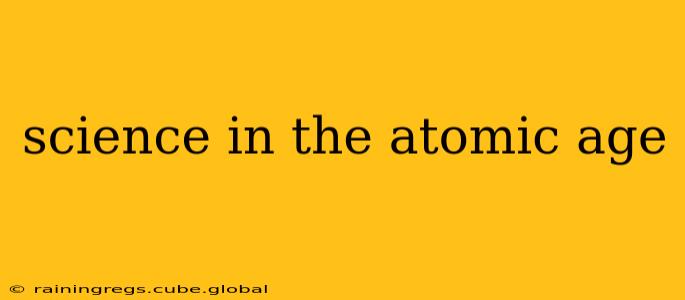The Atomic Age, ushered in by the mid-20th century's groundbreaking discoveries in nuclear physics, irrevocably altered the course of science and human civilization. It wasn't merely the advent of nuclear weapons; it represented a profound shift in our understanding of matter, energy, and the universe itself. This era witnessed an explosion of scientific advancements across diverse fields, fueled by the newfound knowledge of atomic structure and the immense power harnessed from the atom.
What are the major scientific advancements of the Atomic Age?
The Atomic Age fueled advancements across numerous scientific disciplines. Nuclear physics, obviously, took center stage, with breakthroughs in understanding nuclear fission and fusion leading to both devastating weaponry and the potential for clean energy. However, the impact extended far beyond this singular field. Developments in particle physics, spurred by the need for sophisticated instrumentation and theoretical frameworks to analyze nuclear processes, unveiled the fundamental building blocks of matter and propelled the development of particle accelerators. Advances in materials science were crucial, leading to the creation of new alloys and materials with enhanced properties, essential for constructing reactors and handling radioactive materials. Medical science also benefited enormously, with the development of radioisotopes for diagnosis and treatment, revolutionizing fields like oncology and radiology.
How did the Atomic Age change the way science is done?
The Atomic Age dramatically altered the scale and scope of scientific endeavor. The Manhattan Project, the clandestine effort to develop the atomic bomb, exemplified the mobilization of vast scientific and engineering resources towards a singular, high-stakes goal. This model of large-scale, collaborative research, involving numerous scientists and engineers from diverse backgrounds, became a hallmark of subsequent scientific projects, particularly in fields like space exploration and high-energy physics. Furthermore, the ethical considerations surrounding nuclear technology forced a renewed focus on the societal implications of scientific progress, leading to increased public scrutiny and the development of ethical guidelines within the scientific community.
What are some of the ethical dilemmas raised by the Atomic Age?
The development and use of nuclear weapons introduced unprecedented ethical dilemmas. The sheer destructive power of these weapons raised profound questions about the morality of warfare and the potential for global annihilation. The long-term effects of radiation exposure, both for those directly involved in nuclear activities and for populations affected by fallout, presented significant ethical and health challenges. The management of nuclear waste and the prevention of nuclear proliferation continue to pose complex ethical and political challenges that require international cooperation and responsible stewardship. The duality of nuclear energy – its potential for clean power generation versus its inherent dangers – continues to generate ethical debate.
What are some of the lasting legacies of the Atomic Age?
The Atomic Age's legacy is complex and multifaceted. On one hand, it bequeathed us the terrifying power of nuclear weapons and the associated risks of proliferation and accidental disaster. On the other, it unleashed a wave of technological advancements that transformed various aspects of our lives. Nuclear medicine improved healthcare, and nuclear power offers a potential solution to global energy needs. The scientific discoveries of this era fundamentally reshaped our understanding of the universe, and the research methods and organizational structures developed during this time continue to influence modern science. However, its most enduring legacy is perhaps the enduring tension between scientific progress and its ethical implications. We continue to grapple with the consequences of unlocking the atom's power, forcing humanity to navigate a path where scientific advancement must always be accompanied by responsible consideration of its potential impact on society and the environment.
How did the Atomic Age impact different scientific fields?
Beyond nuclear physics, the Atomic Age's ripple effects were felt across numerous scientific disciplines. For example:
- Medicine: Radioisotopes became essential diagnostic and therapeutic tools.
- Materials Science: The development of new materials withstanding extreme conditions became crucial for nuclear reactors.
- Chemistry: Understanding isotopic variations deepened chemical analysis techniques.
- Biology: Radioactive tracers revolutionized biological research.
The Atomic Age's advancements were interconnected, accelerating progress in multiple fields simultaneously.
This period serves as a potent reminder of the transformative power – both constructive and destructive – of scientific advancement and the crucial need for ethical reflection and responsible innovation.
